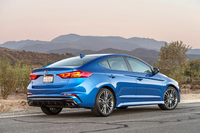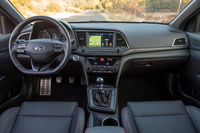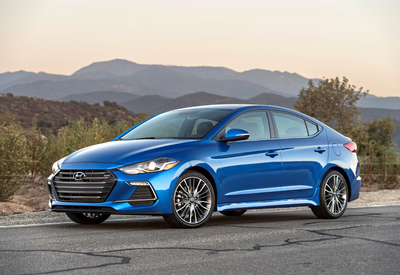2017 Hyundai Elantra Sport Review by Carey Russ +VIDEO
Clean styling, energetic performance, and a sporty driving experience
DRIVING DOWN THE ROAD WITH CAREY RUSS
• SEE ALSO: Hyundai Research & Buyers Guide
 |
If it’s not a hardcore pure-sport machine in the manner of factory tuner cars, neither is its price, starting under $22,000. With a supple but capable suspension tuning, responsive handling, good brakes, and torquey turbo power, it’s an everyday car that can liven up your daily commute as well as it can make a road trip on the backroads a pleasure. And it has a commendably low thirst for premium unleaded — I got 28 mpg for my week, without being light on the right foot at all.
The turbocharged version of Hyundai’s 1.6-liter Gamma four-cylinder sits under the Elantra Sport’s hood. Its maximum 201 horsepower and 195 lb-ft of torque handily beats the naturally-aspirated 2.0-liter engine in the regular Elantra, with 54 more horsepower and an additional 63 lb-ft. Torque peaks from 1500 through 4500 rpm for instant acceleration even without downshifting. The chassis is upgraded to deal with the extra power, with firmer springs and shocks, larger stabilizer bars, and larger brakes. The torsion beam rear axle found in lesser Elantras is replaced by an independent multilink system.
In basic trim, the Sport is well-equipped, with leather seating, front sports seats with power adjustment for the driver, HID headlights and LED running and tail lights, Bluetooth connectivity plus a seven-inch display audio system that supports Android Auto™ and Apple CarPlay™ and Sirius/XM satellite radio and traffic and weather services (subscription required after a free three-month trial). The Premium Package option pack adds a larger touchscreen, 8-speaker Infinity premium audio, a sunroof, blind-spot detection with rear cross-traffic alert, dual-zone automatic climate control and more for an additional $2400.
And of course my test example was so-equipped. That does add upscale convenience, but is hardly necessary. My test car also had three pedals and a lever on the center console. Some of us still link “Sport” with real manual shifting, so congratulations to Hyundai for outfitting the Elantra Sport with such. It works very well and adds driver control and involvement. And perhaps a bit of theft protection… Hyundai is not usually on the short list for energetic small sedans, but with the debut of its Elantra Sport, it should be. It’s priced for value, but you give up very little compared to other small, sporty sedans and hatchbacks. As is, it’s more “sport-touring” than pure sport, and all the better in the real world for that. If you need more, take the money saved and put it in the suspension — but there’s nothing wrong with the stock setup.
APPEARANCE: All current Elantras have clean, simple lines. Yes, the head of design is European. Differences between the Sport and regular Elantra are minimal but appropriate. Front and rear bumper fascias are changed, with the Sport getting gloss black surrounding trim instead of chrome, and fancier chrome and black crossbars. “Turbo” appears in small script in the upper left section. The semi-functional vents to the sides of the grille are unique to the Sport, as is the chrome strip around those and LED bar at the tops. The lower front has a “splitter” appearance, but clearance is good. Sill extensions are found on the sides. The Sport’s lower rear fascia has a gloss-black faux diffuser and twin exhausts. The result is handsome and not over-done. No lurid graphics or picnic tables on the deck lid to attract undue attention. Unexpectedly for the Elantra Sport’s modest class, the trunk opens if you stand near to it (convenient sometimes, and programmable so it won’t always do that) and LEDs in the outside door handle pockets aid entrance at night.
 |
SAFETY: The Hyundai Elantra Sport has front and rear crumple zones and a safety cage around the passenger cabin. Four-wheel antilock disc brakes with brake assist and electronic brake-force distribution ensure quick stopping, and cornering and evasive maneuvering are improved by vehicle stability management and electronic stability control systems. A full complement of airbags, including driver’s knee offer further protection. A rearview camera is standard, as is a tire-pressure monitoring system. Blind-spot detection with rear cross-traffic alert is part of the Premium Package.
RIDE AND HANDLING: A rigid and well-designed unibody structure provides solid footing for the Elantra Sport’s suspension. The front is the same MacPherson strut design; at the rear the regular Elantra’s torsion beam axle is replaced by an independent multi-link system. Front spring rates are 14% higher here, with rear increased 22%. Damping is increased 30% all around, and the front stabilizer bar is thicker, 24mm vs 22, with a 15mm bar on the rear. The result is a comfortable and compliant ride, and good maneuverability and handling characteristics. The electrically-assisted steering is a bit over-assisted, not unusual in a front-wheel drive car. In stock trim, the Elantra Sport should make a fine daily driver for anything from commuting to long trips on any sort of road, the more interesting the better. Eighteen-inch wheels with low-profile all-season performance tires and larger front brake discs complete the package.
PERFORMANCE: Not long ago it would have taken a 2.5 to 3.0-liter V6 to produce the 201 horsepower and 195 lb-ft of torque available from the Elantra Sport’s 1.6-liter turbocharged, direct-injected four. That would have meant more weight, over the front wheels where it would adversely affect handling, and a tight if not impossible fit. And lower gas mileage. Turbo for fuel economy? In this case, yes indeed — not trying for best mileage at all (mostly the opposite) I easily saw low to mid 20s around town and 30-plus on the highway, with an overall 28. Power delivery is very linear, no surprise as maximum torque is produced from 1500 through 4500 rpm, where most driving is done. There is a bit of a surge around 5000, with maximum horsepower at 6000 and little reason to exceed that. Or, usually, even get close. Shift linkage is good, with a light clutch and good pedal placement for enjoyable driving.
CONCLUSIONS: Clean styling, energetic performance, and a sporty driving experience make the 2017 Hyundai Elantra Sport a stealthy small performance sedan.
SPECIFICATIONS
2017 Hyundai Elantra Sport
Base Price $ 21,550
Price As Tested $ 25,010
Engine Type turbocharged aluminum alloy DOHC 16-valve inline 4-cylinder with direct fuel injection and variable cam phasing
Engine Size 1.6 liters / 97 cu. in.
Horsepower 201 @ 6000 rpm
Torque (lb-ft) 195 @ 1500-4500 rpm
Transmission 6-speed manual
Wheelbase / Length 106.3 in. / 179.9 in.
Curb Weight 3064 lbs.
Pounds Per Horsepower 15.2
Fuel Capacity 14.0 gal.
Fuel Requirement 91 octane unleaded premium gasoline
Tires 225/40 R18 88W Hankook Ventus S1
Brakes, front/rear vented disc / solid disc, ABS, EBD, BA standard
Suspension, front/rear independent MacPherson strut / independent multilink
Drivetrain transverse front engine, front-wheel drive
PERFORMANCE
EPA Fuel Economy - miles per gallon city / highway / observed 22 / 30 / 28
0 to 60 mph est 6.7 sec
OPTIONS AND CHARGES
Premium Package — includes: Navigation system, 8-speaker Infinity audio system with Clari-Fi music restoration technology, Hyundai Blue Link® connected car system, blind-spot detection and rear cross-traffic alert, power sunroof, dual-zone automatic temperature control, auto-dimming rearview mirror with Homelink and compass $ 2,400
Carpeted floor mats $ 125
Destination Charge $ 835



